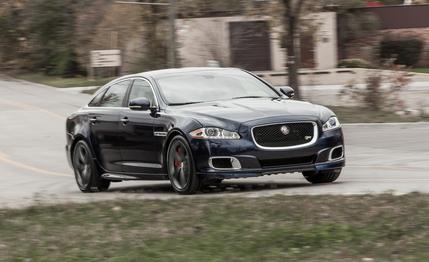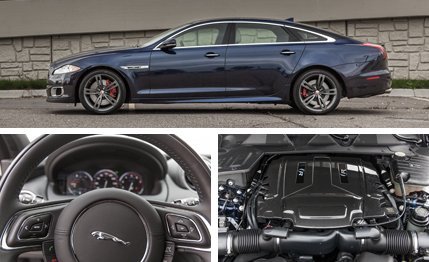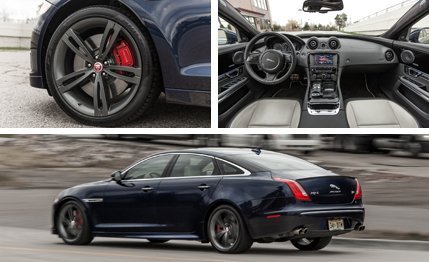
 Instrumented Test
Instrumented Test
Jaguar is busy honing its identity. Its portfolio is bursting with high-tech mills and sales are up, but as volumes approaching those of its competitors will take time to develop, image is a quicker build. And Jaguar wants to be seen as a full-fledged equal to the German luxury brands. Fortunately for us, the Germans all have performance divisions, and Jaguar wants its R subbrand to be thought of as contextual with AMG, M, and Quattro.
So, absent since the current-generation XJ debuted, the XJR is back, because what’s a flagship performance subbrand without a flagship? The XJR’s supercharged 5.0-liter V-8 is cranked up from a previous high of 510 horsepower in the XJ Supersport—it disappeared when the XJR went on sale—to 550. Torque increases from 461 lb-ft to 502. Both figures nicely square up against this car’s competitors—except for the totally gonzo Mercedes-Benz S63 AMG. This being a supercharged 5.0-liter V-8, the changes necessary to realize such gains amount to a little bit of ECU tweaking. The fruit of those tweaks travels to the rear tires through the same eight-speed automatic transmission as that found in other XJs, although the electronically controlled differential gets minor programming changes to suit the fiercer character of the XJR.
The standard XJ is already the sportiest of the full-size luxury pack, but the R sees its springs and adaptive dampers firmed up by 30 percent and its steering fine-tuned for a sportier feel. Executive-class rockets typically don’t get too ostentatious with their exterior decoration, and neither does the XJR. A unique front fascia, rocker panels, and a lip spoiler are the extent of its bedazzlement. Inside, the only major difference from less-powerful XJs is the sport buckets for the driver and passenger.


Arguably, there’s no better venue to reflect on Jaguar’s performance image than a racetrack. So it was fitting that we first experienced the XJR at Seattle’s challenging new Ridge Motorsports Park, where we examined whether the hardware in the 550-hp, 4365-pound sedan could hold up its end. The XJR’s all-aluminum construction keeps it light for this class—lighter, in fact, than the XFR that sits below it in Jaguar’s lineup. At the track, we found that even the long-wheelbase XJR felt fantastically responsive and nimble, the lengthy span between front and rear axles endowing it with superb stability at all speeds. With steering that was weighty and immediate and brakes that placed uncommon strain on optic nerves, it became obvious the chassis was developed with track use in mind. Although the XJR’s tailpipes didn’t emit the raspy bark of the XFR (or, for that matter, the F-type roadster), the flagship sedan’s exhausts had sufficient growl to turn the heads of bystanders. As well they should have, as the XJR was reaching velocities well north of 145 mph at the end of the Seattle track’s roughly half-mile straight.
Those early track impressions were validated in subsequent instrumented testing back on our home turf in Michigan, where we strapped our test gear to a long-wheelbase car. The R established its range-topping dominance over the old XJ Supersport with a 3.9-second 0-to-60 run, which also beats BMW’s 12-cylinder 760Li and the last-generation Mercedes-Benz S63 AMG (we haven’t tested the current model yet) but loses out to the beastly all-wheel-drive Audi S8. The R’s giant 15.0-inch front and 14.8-inch rear brakes hauled it down from 70 mph in an expedient 157 feet, and the Pirelli P Zero tires stuck for 0.90 g around the skidpad.


Cars in this class are almost antagonizing in their perfection. The Audi S8 and the Mercedes S63 AMG excel at seemingly every last detail. The XJR, however, avoids fussiness and makes an emotional appeal. It engages the driver with abundant personality. Yes, there are quirks: The XJR’s steering borders on twitchy, the ride is less silky, and the ZF eight-speed’s downshifts can stumble a bit in Normal mode (but they tighten up in Sport mode). Also, we noticed the traction control could be slow to kick in on slick roads, leading to copious tail wagging with all but the gentlest throttle inputs; we found this fun, but anyone coming out of a traction-abundant Audi might be put off. Still, the Jag feels focused, its purpose helping it to show a little swagger in the face of the German overachievers. Even so, those overachievers’ smoother rides would probably make one of them our preference if we had to drive over our nation’s tortured roads tomorrow to, say, Oklahoma. But if we could pick the route and maybe find a few side roads with which to exercise this car’s charms, we’d be leaning toward the Jag.
This story was originally published in August 2013 as a first-drive report. It has now been updated to include instrumented test data and real-world fuel-economy figures.